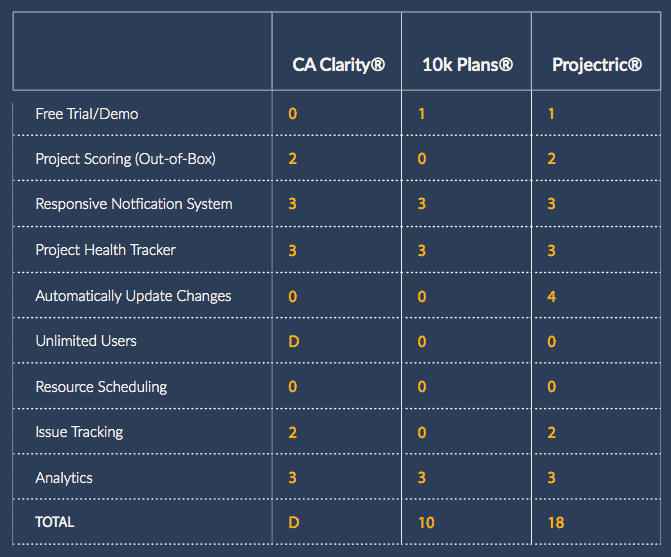Quick Take:
- Use this process for any kind of software:
- Ask yourself why to you need the software and make a list
- Create a list of features that will answer the \”whys\”
- Based on the feature list, research software providers
- Select your top five
- Do a side-by-side weighted comparison to rank providers
Use a Criteria-Based Assessment to Evaluate Software Solutions
Projectric recommends a five-step criteria-based assessment for evaluating any software solution. We\’ll use the Projectric Project Portfolio Management (PPM) software solution as an example.
The first step is to determine organizational needs that a software solution could meet.
1) Ask yourself “Why Do We Need PPM?”
Many organizations evaluating Project Portfolio Management software are seeking to:
- Easily select the right projects
- Organize projects
- Track the budget and health of projects
- Communicate about projects
- Ensure that solutions are sustainable, maintainable, and usable
Make sure you understand your organization\’s needs thoroughly before moving to the next step.
2) Decide which features you absolutely need in your solution
Based on your “Why” list, describe the software functions you require to fulfill your goals. Create a list of features that you can use to check prospective software for fitness. You may want to establish a hierarchy of needs that you can use in a later step to score software candidates.
The Software Sustainability Institute has a good white paper on this process.
For our PPM exercise, let\’s use these commonly desired PPM features:
- Project Scoring (out-of-the-box)
- Responsive Notification System
- Project Health Tracker
- Data Security Features
- Automatic Updating Changes
- Unlimited Users
- Resource Scheduling
- Issue Tracking
- Analytics
The intent of this stage is to identify your must-have and nice-to-have features. To do this, you should do a ranking exercise to produce a final list.
3) Select your PPM software provider candidates
The next step is to canvas your industry to select software solutions that meet the criteria you have established. In this phase, you\’ll want to determine if candidates are likely to be long-term partners.
You may want to do online searches, or ask your peer organizations, or solicit recommendations from industry analysts.
4) Do a side-by-side weighted comparison
Rank the various prospective solutions against your list of must-have features. Using the rankings, eliminate the low performers until you have a short list of three to five contenders (the fewer the better).
Now you can concentrate on your short list and can do a more intensive review and ranking to illuminate how providers stack up. See this sample comparison chart and legend.

You\’ll want to take into account total cost of ownership including the upfront and hidden costs. You may also want to score
Relevance
How closely aligned with your problem space is the software being considered? Is the software made primarily for a particular industry or problem and if so, can it be made to work with your organization?
Efficiency
You may want to evaluate several demos of the software and the processes users will go through to achieve results.
Effectiveness
How likely will you be able to achieve your most important objectives? How easy is it for users to use the software?
Impact
Try to forecast how the software will affect your current workflow and outcomes. Try to determine potential positive and negative effects. Will the software require substantial changes in the way your organization does things?
Sustainability
How sustainable is the solution? Could you see your organization using this software for the next 5, 10, or 20 years?
The Decision
From your final analysis, you should have enough data to make your final selection. We wish you the best of luck!
If you\’d like to evaluate Projectric\’s solution, schedule a demo or contact us today to see how Projectric can illuminate your project portfolio.

